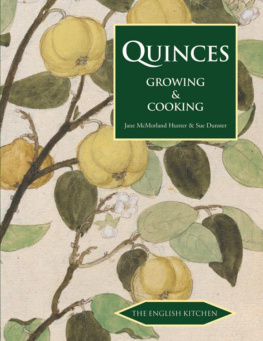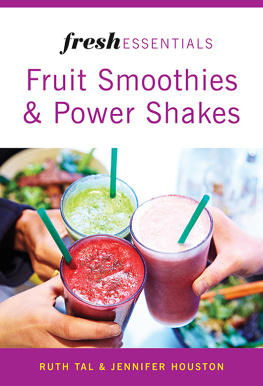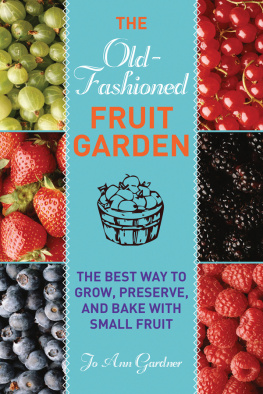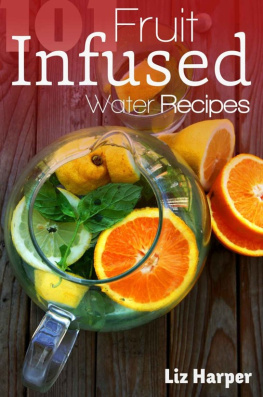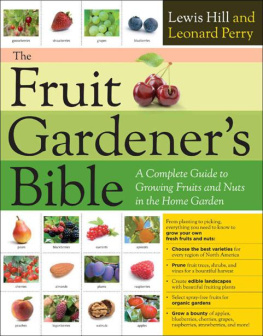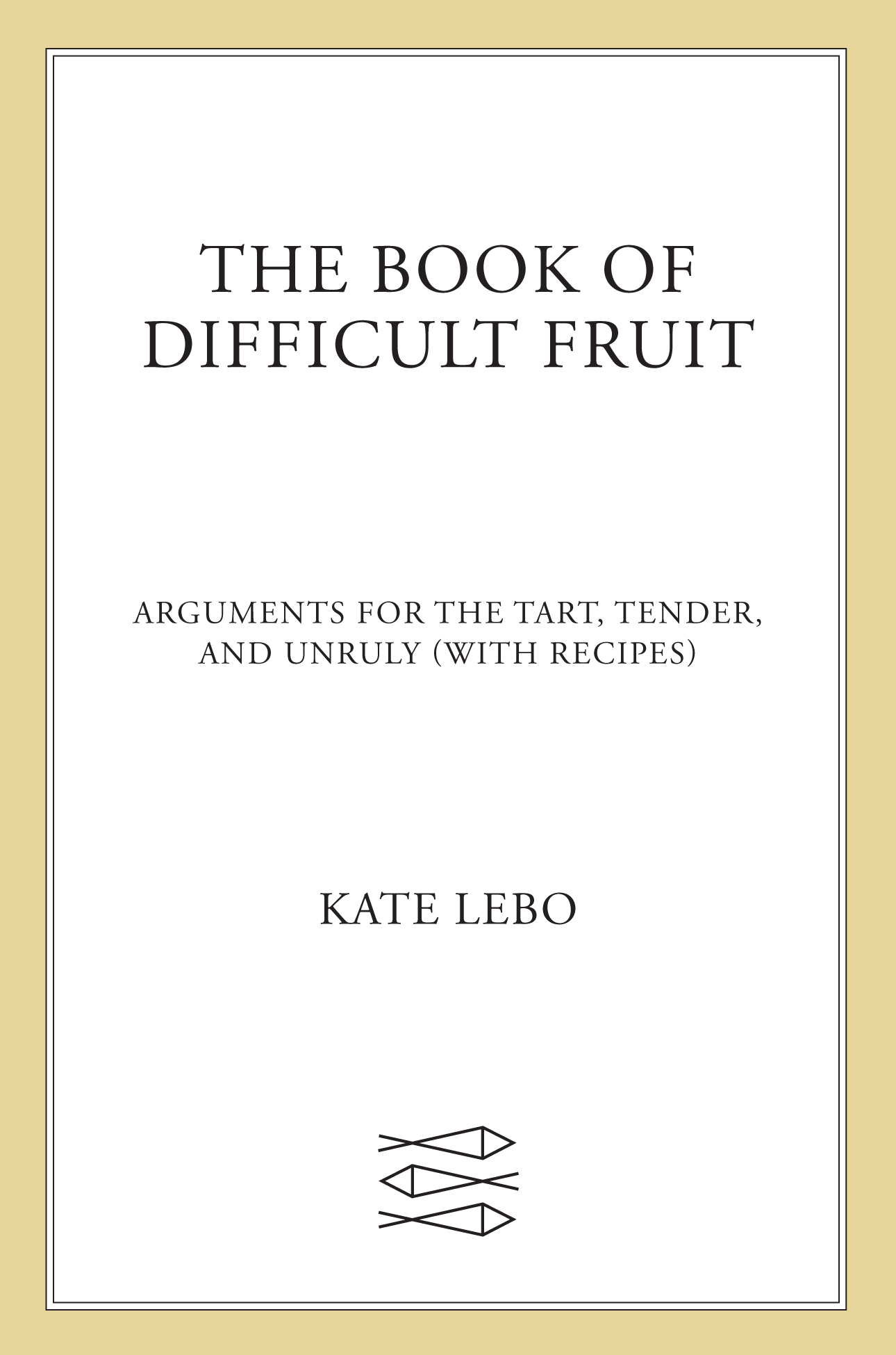Fruit is how I best relate to plantsbeing myself an animal, and hungry. You do not eat / that which rips your heart with joy, Thomas Lux writes. But of course you do. We the animals are pleased to fulfill fruits highest purpose: after frost and flower and water and light, to be cherished, carried off, and gobbledcore flung from a window, pit hocked over a rail, seed shit in the dirt, under the sun.
In this book, fruit is not the smooth-skinned, bright-hued, waxed and edible ovary of the grocery store. Nor is it a symbol of goodness and kindness and productivity and the virtues of civilization. Here, fruit is difficult. Blackberries are invasive. Huckleberries cant be farmed. Medlars must rot in order to sweeten. Wheatberry dust is more explosive than gunpowder.
Consider the apricot. To a small child, apricot kernels can be toxic if eaten. To the sick, the same kernels might be medicine. To the cook, they are a secret source of flavor. To the consumer who knows no better, the pit and kernel are garbage to throw outwhich suits the fruit best of all.
Fruit of the womb, we say. Or fruits of my labor. What precedes the bounty contained by these clichsthe thing obscured but not erased by the feast, the mechanism that brings fruit to fruitionis pain.
Each fruit in this book is difficult in its own way. Some are impossible to domesticate or tough to prepare. Some can be medicine or poison, depending on the size of the dose. Some are an acquired taste; some cant even be acquired. Here, their culinary, medicinal, historical, cosmetic, and cultural roles show us where what nurtures and what harms are entangled. Imagine a blackberry briar, forbidding and sweet, and follow me in
Recipes are rituals that promise transformation. They blend the precision of an instruction manual with the faith of a spell and, no matter when they were written, occur in the present. In this book, I use them to suggest additional ways to experience each fruits qualities and difficulties. You can skim them, if you prefer. Doing so wont interfere with your reading experience.
Most of these recipes will transform a fruit by using a small number of ingredients and simple processes. Often, the cook will need more patience than skill. A few of these fruits require precise, repetitive preparations that will drive some people crazy and send others into raptures. Youll find out which type you are soon enough (though if you want to test it, start with persipan ). Keep in mind that many of these recipes will adapt to other fruits. A thimbleberry kvass can be a raspberry or blueberry or mulberry kvass instead.
Some will require special tools. If you dont own a mortar and pestle, and youre interested in cooking, buy one. Its a tool used by pharmacists and cooks, the perfect accessory for this book. Get a food scale, a quick-read thermometer, and glass jars. Make sure to have a preserving panheavy-bottomed, ovenproof, nonreactive cookware like a wide stainless-steel saucepan, enameled Dutch oven, or copper jam pan. Buy a yard of good cheesecloth from a fabric store. Look up local orchardists and farmers. Ask neighbors and friends for extra/strange/mysterious fruit, if you live in the sort of place where thats possible. Consider growing your own.
I measure ingredients in U.S. customary units and the metric system, switching back and forth according to convenience. For example, I find it much easier and more precise to calculate the fruit-to-sugar ratios of jam using metric measurements, but when Im making less variable quantities of pickles and beauty products, cups and ounces are easier. Specialized cooking techniques are spelled out within each recipe.
I am a home cook. My methods and style are inherited and gleaned. I would not call my training formal. Nor have I felt the need for formal training. Everything I know about cooking comes from apprenticeship to master domestic artists, a cookbook habit, online food forums and blogs, my family, and years of fooling around in the kitchen. No matter how deeply I researched difficult fruits, the most essential information came when I gathered, cooked, and ate them. In essence, these recipes are invitations. Try this at home.

Aronia melanocarpa
Rosaceae (rose) family
Also known as chokeberry, black chokeberry, barrenberry, chokepear
Aronia berries taste vegetal like a grass stem, then sour like a crabapple, with a tannic pucker that rivals raw quince and deep-purple juice that stains teeth like wine. Aronias folk namein many places still the name theyre best known byis black chokeberry, earned by what you do when you eat them.
Member of the rose family and native to the Eastern half of the United States and Canada, aronia grows wild in good or poor soil, in meadows or bogs or roadsides or the edges of oceans and lakes, a cold-climate bush that loves full sun. It has been farmed in Eastern Europe and Russia for wine making, food coloring, and dessert flavoring since the mid-twentieth century, but only recently have American consumers shown any interest. Today, the co-ops and health-food stores where aronia might be found usually sell it as superfruit: natures medicine, chewable by the handful if you can stand the taste.
Aronia berries are high in polyphenols, the phytochemicals with antioxidant properties advertised to prevent cancer and banish wrinkles, allowing us to imagine an invisible serum that can slake, slough, or soothe the rust from our oxidizing, time-sensitive bodies. Anthocyanins give the berries their deep color and antioxidant load, while tannins contribute a dry, overpowering taste so strong that most people cut aronia berries with milder fruit to choke them down. Tannins often accompany anthocyanins, which means darker fruit tends to be more astringent. To get the most nutritional benefit, take aronia straight. The operative rule here, as it was in my childhood home: the worse it tastes, the healthier it must be.
My mothers best scheme to convert me to her health rituals is a fruit smoothie. She starts with leafy greens in a blender, pours hot ginger tea over the greens to cook them slightly, then adds blueberries, two tablespoons of ground flax, and a banana, and blends until liquefied. The blender we use to make this drink shares the name of the hope we place in drinking it: Magic Bullet, or something that cures or remedies without harmful side effects. I often confuse magic bullets with silver ones, which do something elsekill mercurial monsters efficiently.
Lately, Ive replaced the blueberries in my mothers recipe with aronia berries. I would believe they are three to four times healthier than blues even if their packaging didnt say so, because they immediately assert their potency: they stain everything they touch with a deep purple thats not like blood but reminds me of it. When I smash an aronia berry between my thumb and the kitchen counter, I make ink that doubles as a nutritional supplement.




